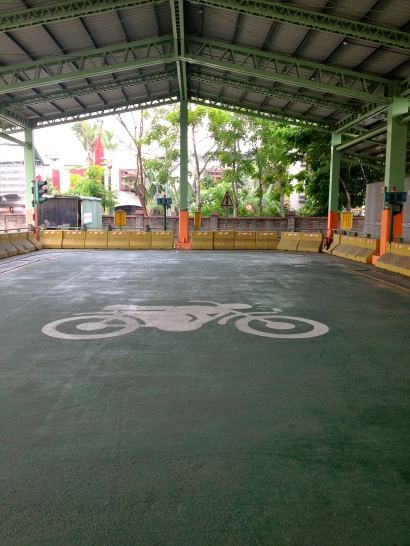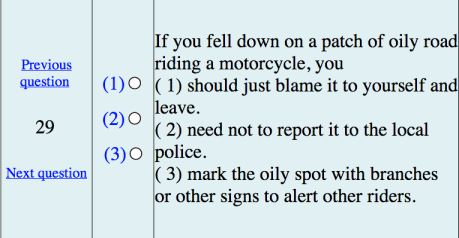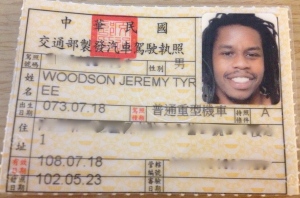A few months back I bought a scooter and have been ziping around Kaohsiung ever since. I was initially nervous about making the purchase because of two low-speed, minimal-impact crashes I was I in; one in Indonesia (not my fault) and one in Vietnam (very much my fault).
Many expats told me not to worry about getting a scooter license because in the unlikely event that you get pulled over the cops will almost for sure let you off the hook once they notice you’re a foreigner. I can’t say whether that’s true or not, but I had all but written off getting a license until I was denied a rental scooter on Green Island on the basis that I didn’t have one.
In some ways I find it odd that Taiwan even requires drivers to have a licenses for operating scooters considering what passes for acceptable driving here: blasting through intersections well after the light has turned red; coming to a near complete stop in the middle of the street to ponder the design of a new tea shop; speeding down a busy sidewalk to avoid congestion at a traffic light. All of these are damn-near everyday occurrences and seem to be completely acceptable as normal driving practice.
Still, if a scooter license is needed for foreigners to rent a set of wheels around Taiwan, then getting one makes perfect sense.
To be honest, I tend to handle situations like this as half-assedly as possible. When I took Driver’s Ed. in high school, I completed the whole course then skipped class on the day of the written test to avoid paying for the mandatory behind-the-wheel driving practice. Months later–after turning 18–I strolled into the local DMV, knocked out the written test, had the 6-month permit period cut in half and took the driving test with little to no practice. Yes, I had to wait longer than most of my peers, but I saved more than a hundred bucks doing so. Genius.
I probably would’ve never gotten around to getting a scooter license in Taiwan if the school my girlfriend works for didn’t let me tag a long when they organized it for her and a few other teachers.
Essentially it’s a 3-step process: physical examination, written test and driving test.
Physical Examination:
Before taking to the road Taiwan needs to see that you can physically operate a scooter. On the morning of our physical the obvious assumption is that it will take place at a small pristine health clinic where blood will be drawn, reflexes will be tested, and eyesight will be checked.
Instead we pull up to a dingy run-down building on a sketchy looking narrow street. By outward appearance it seemes as if the place was really a front for some other less-than-legal enterprise.
The room is dimly lit with dusty grey wall and a lone table with a few chairs serve as a waiting area. The only medical looking devices in the room include a weight scale and an optical contraption that is positioned in such a way that allows patients to look into it while seated in front of the table. I begin thinking it’s the type of place where–with a special code word–one can score more than just a physical exam.
“Yes, I’m here for the driving physical and…’bubble tea.'”
The first lady I come to calmly studies my ARC and checks that I have all the correct paper work and the required number of passport photos before taking my weight and sending me to the second nurse. This lady checks my eyesight by first asking what color she’s pointing at on small flashcard and then directing me to look into the aforementioned optical device and spout off the position of a gap in a series of different sized circles. It takes a moment to understand what i’m supposed to do so the nurse holds up a notecard with English instructions printed on it. She does this two more times before I’m able to get it right. 
The next part of the exam involves an elderly Taiwanese gentleman sitting at a desk in the back of the room reading a newspaper. He motions for me to first hold out my hands palms up, then close them and open them again. We then hold hands for a second and he examines the backs of my hands. I’m not sure what he is looking for, but I’m somehow nervous about what he might find. Can he see that I’ve previously been in a scooter accident? Is he looking for signs of excessive beer consumption? Is he judging me for not having applied enough hand lotion? Does he notice that I bite my fingernails? Does it matter that I bite my fingernails? Am I being scouted to participate in an underground martial arts tournament?
Before letting my hands go he looks into my eyes (into my soul?) and gently asks me where I’m from. The tone of his voice prompts me to answer slowly in a complete sentence.
“I am from the United States of America.”
He smiles, nods approvingly and sends me on my way. I linger for a moment, wondering if I’ve somehow missed a meaningful revelation, then head out.
Written Test
After a visit with the scooter shaman, you’ll need to then pass a written test to demonstrate that you know all the Taiwanese traffic laws that are hardly obeyed and rarely enforced.
The test is made up of 40 questions–half multiple choice and half tue or false. Besides traffic laws and road signs, the test also covers driving ethics. A passing score is 85% or higher. Fail it and you’ll need to wait a week before you can take it again.
Taiwan has been kind enough to create an English version of the test and even provide study materials and a mock test for practice, but the translation leaves something to be desired. Take this true or fase question, for example:
The correct answer is True (or “O” on the actual test), leading one to believe that–if nowhere else in the world–at least Taiwan has a safe place for zebras to cross the street.
Still, even with the translation errors, some questions leave no doubt as to the correct answer…
while others are undoubtedly confusing:
I have yet to see any slick roads covered with branches, but I’m constantly on the lookout.
Taking the test will set you back $125 NT.
After paying the fee our group is led into a bright room with 3o or so computer terminals. Once again my ARC is checked closely and I’m shown to the terminal where I will take my test. I’m feeling confident about my chances of passing despite having hastily studied the night before over dinner and a few beers. I took the practice test as many times as it took to pass (twice) and was satisfied with my preparation.
The test takes about 15 minutes to complete and I just barely pass with 87%. On the way out I’m handed a slip of paper that will allow me to take the driving test.
Driving Test
I have no problem fully admitting that taking the driving test was the most difficult part of getting my Taiwanese scooter license. Even with plenty of practice and a clear understanding of the manuevers I needed to execute I still had doubts about my odds of passing. The test course is nothing special, mind you; a simple U-shaped obstacle course under a sheet metal roof that, if done properly, should take no more than 45 seconds to complete.
We arrive before the 10:30 AM test time and are allowed to practice. Most of the course is simple. There’s two places where you need to signal your turns, two places that require making complete stops and a stop light thrown in for good measure. All of these elements need to be properly executed within the confines of a three foot wide track with sensors on either sides. Veer off the track and a loud siren will sound (with lights) signaling your failure.
By far the most challenging part of the road test, however, is a 50 foot narrow strip at the beginning of the course. The object is to drive the length of it in no less than seven seconds (there’s a timer right in front of you). Touch the sensors on either side of the strip or touch your feet to the ground and it’s an automatic fail.
I nail the entire course time after time while practicing. At this point our small group are the only people there, but by the time the test is about to start a crowd of test takers and on-lookers has formed and a few people have taken a keen interest in how the foreigners will do.
Before the start of the test an administrator walks us through the course explaining all the elements and possible point deductions in Chinese. I can’t understand what he’s saying, but I stroll with the others anyway, nodding my head every so often to show that I’m paying attention. I don’t notice that there’s English instructions printed on a large board near the beginning of the course until he’s finished.
As the test begins I position myself in the middle of the pack so I can see how the first few people do on the narrow strip portion. Some are wobbly in their method, but most everyone gets through it without any problems. Some people ease their way through it gently twisting the throttle to give the scooter as little thrust as possible while focusing on maintaining balance. Others hit the gas right away and then let off, relying on their break at the end so they don’t finish under seven seconds.
As I approach the start I notice that several people have gathered along the side rail near the 7-second balance strip. I give myself a small peptalk: “Don’t f**k this up, Jay. All of Taiwan is watching.”
I decide to gas it at the beginning and coast the rest of the way. By the time I make it to the end the timer is only at four seconds so I gently squeeze the brake to buy more time. This slows me down too much and my scooter begins to lean to the left. I clip the left corner of the sensor and the sirens wail. The administrator waves me back to the beginning of the course to start over. I have one more chance to pass it then I’ll have to wait a week before I can try again.
On the second attempt I try to ease my way through the strip, twisting the trottle as little as possible, only this time I don’t have enough power and I’m forced to put my feet down to keep from tipping over. I’m once again waived over and given my test sheet with a big red stamp on it.
Out of our small group of foreigners that took the test I’m the only one who fails the driving test, but Im not alone. After everyone is finished,and at the insisting of the test administrator, I take turns practicing on the course with a with a teenage Taiwanese girl who also didn’t pass. It’s feels like a victory lap for losers.
The next week I return by myself, pay the $125 NT fee to take the test again. When I finally pass the annoying seven-second narrow strip (I fail once more before getting it right) I almost forget that I have to finish the rest of the course. I halfway expect someone to be clapping for me when I approach the booth to get my licence: a small piece of paper laminated on one side with my name and the same shitty pasport photo I used for my diving certificate.
For $200 NT, victory never looked this good.
Links:
Study guide for written test
Practice test
Extra info from Tealit.com








You write with brilliance and truly make me LOL. Miss you
Just read your post, found through a random google search – I was in Taiwan earlier this year, and I’m amazed to hear that the scooter test is so thorough – who ever thought the shaman scooter would need to get involved? Quite a few ex-pats told me that they never bothered taking it.
Incidentally, in British English a “zebra crossing” is the commonly used term for a pedestrian crossing with white stripes on the road, which is where I guess they got that translation from!